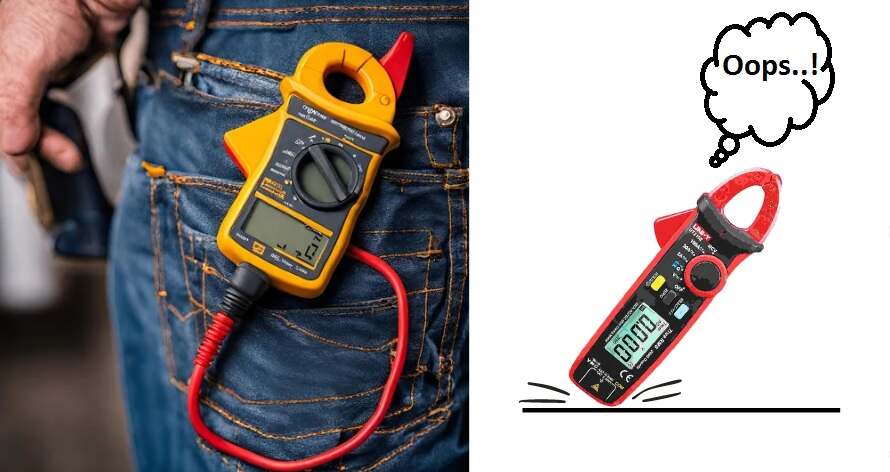With the advent of new technologies, the field of instrumentation also changed. New instruments changed the course of measurement and got more accuracy than the previous one.
A clamp meter is an essential tool for the measurement of current safely and accurately. Every professional and non-professional needs a clamp meter to deal with electric circuits.
“How to pick the best clamp meter?” is frequently asked.
Being a professional engineer, I always check the capability of a clamp meter along with its physical endurance. The range of voltage, current, safety category, and mechanism lie in the area of capability. By Physical endurance, we mean the toughness, durability, and sustainability of a clamp meter. Additionally, the brand name is a significant factor when buying a clamp meter.
Hence, this blog is a complete buying guide for a clamp meter for professionals and non-professionals.
Stay with us till the end…
Buying Guide for a Clamp Meter
A clamp meter is an instrument for measuring electric current (both AC & DC). The basic concept behind its design is accuracy and safety.
However, the market is flooded with different types and designs of clamp meters. We need to check certain things to get a clamp meter.
What to Look for in a Clamp Meter?
The prime concern of buyers is to get a clear idea of the instrument they are buying. But before going any further, buyers should assess their demands, budget, and workplace.
According to these aforementioned, consider the following points.
1. Range of Electric Parameters
The range of different electrical parameters is our prime concern. Let’s discuss these parameters one by one.
The current is the first factor one must check for. It tells us the measuring capability of a clamp meter for current. We should always go for the highest value of current. We can also check for AC or DC according to our demand.
Although the voltage is not our prime target, we need to have it reckoned. Again, the highest value is the best value. It depends on our needs. As we mentioned earlier, check for your needs before getting one.

Modern clamp meters are installed with many other auxiliary functions. We need to take a good look at these parameters. Commonly, we witnessed the following functions:
- Measuring Temperature
- Measuring Resistance and Capacitance
- Measuring Frequency
- Testing diode
- Testing connectivity
Be aware, do not compromise on accuracy no matter how fancy a clamp meter is.
2. Safety Category (CAT)
Nothing is more important than our safety. We should feel safe while taking a reading.
For this purpose, the safety category is mentioned on every clamp meter. These safety categories are the following:
- CAT-I safety tells us we can use this clamp meter for appliances not directly connected to an AC power source. For example our laptop, or other battery-powered appliances.
- CAT-II safety allows us to work with plugged-in appliances to the main AC socket. For example, washing machines, Power drills, fans, etc
- CAT-III safety extends our workplace to electrical installation. Here, things get serious. We would deal with the main switchboards, circuit breakers, industrial equipment, etc
- CAT-IV safety allows us to work in power distribution panels. The main circuit of our infrastructure is powered from here.

We can check this safety category on the jaw clamp of a clamp meter. Some models also mention it at the bottom of the clamp meter below the display.
3. Working Mechanism
The working mechanism of a clamp meter is as important as its parameters. This factor explains many things to us.
Let’s say, we get a digital clamp meter. It means the internal structure and function work on the principle of digital electronics. This guarantees us a few things:
- Accuracy will be high
- Chances of maintenance and repair are low
- Physical toughness is promised
- The size and shape might be smart
- Could weight more
Similarly, Analog clamp meters, HVAC clamp meters, and power clamp meters have their separate use and have different workplaces from each other.
Nowadays, clamp meters are available with Bluetooth connectivity. This not only improves remoteness but also helps us to record the data.
4. Physical Features
The physical features of a clamp meter tell us about the physique of a clamp meter. It includes many parameters. We are discussing each parameter with its impact.
The size of a clamp meter matters a lot when we talk about fieldwork. The smaller size improves the capability to carry it. Field engineers prefer small clamp meters for monitoring while electricians need them for comfort.
The shape of a clamp meter is equally important as its size. Both improve the flexibility of the clamp meter.
The toughness and durability combine and give us a sustainable clamp meter. The toughness gives us the freedom to perform different tasks in different environments

Always consider these factors before getting a clamp meter for yourself.
Things to Avoid
Users need to be more careful while buying a clamp meter. Because one can easily mislead users with their unorthodox method of explanation.
Upon our observation, we listed a few mistakes below. These are commonly occurring and need to be avoided.

1. Opting for a Brand Blindly
This may sound strange but it is true for many cases. Never blindly trust any brand before using its product. If you are acquainted with that brand, then it is fine.
Alternatively, you may take guidance from a professional about a brand. This is the shortcut for a successful purchase.
2. Ignoring Safety
The majority of our clients need to learn about safety categories. Hence, they do not consider this factor during purchase.
Be advised, to always check the safety category and go for a clamp meter that suits best your use.
3. Relying on a low Budget
It is our dream to get a perfect clamp meter at the lowest possible cost. This dream is fulfilled in some cases but at the cost of accuracy, durability, and sustainability.
Often, our clients report the dysfunctional clamp meter they just bought. It happened because they wanted to save some money. However, this act cost them more than a good clamp meter.
4. Trusting Unreliable Brand
Famous brands like Fluke and Klein have been in the business of manufacturing clamp meters for a decade. Besides them, Kaiweets, UEi Instruments, and UNI-T are some of the emerging brands.
Unfortunately, there are some unreliable brands in the market. These brands produce low-performing, less accurate, and delicate clamp meters.
Conclusion
A Clamp meter is a tool that measures the current (both AC and DC) accurately and safely.
One must go through some important factors before buying a clamp meter. These factors vary from user to user. Every user needs a different clamp meter from others.
The range of different electrical parameters is the key factor to check while looking for a clamp meter. This may include current, voltage, frequency, resistance, temperature, and capacitance.
Along with parameters, consider the safety category, working mechanism, and physical features of a clamp meter as these factors are crucial for accurate and reliable current measurement.
Last but not least, avoid any blind pick and trust a reliable brand without ignoring safety and accuracy.
Remember that investing in a good clamp meter can improve the accuracy as well as reliability of your work.
Other useful posts:
